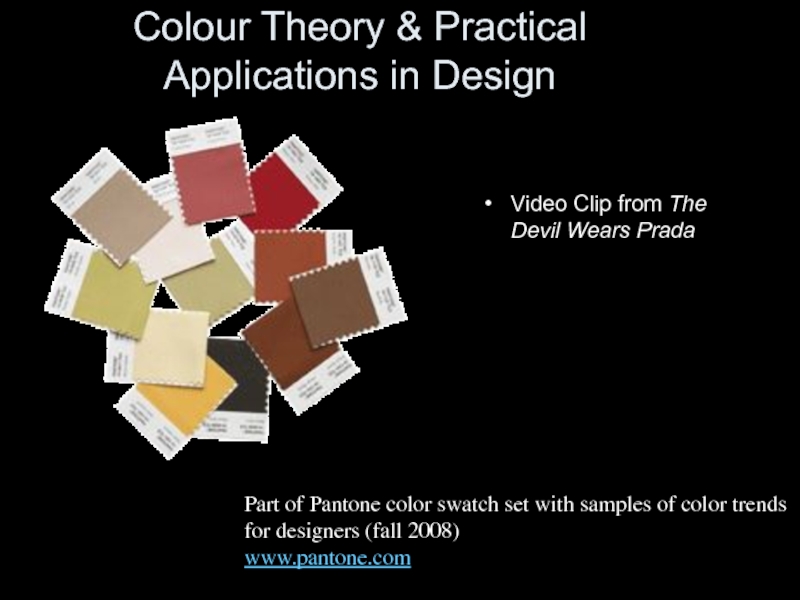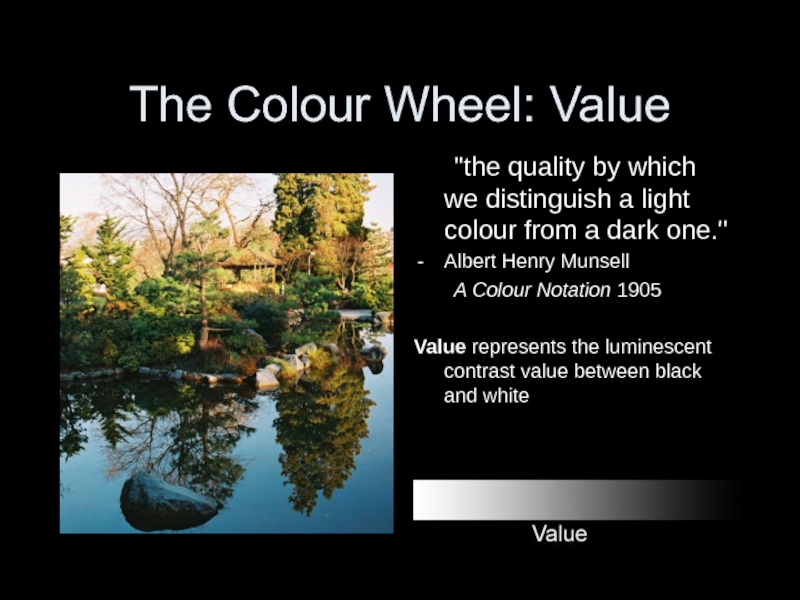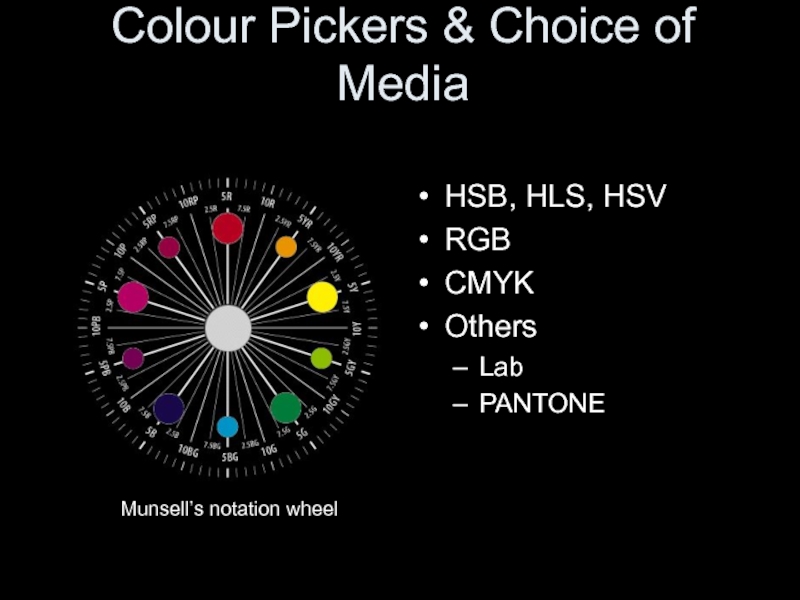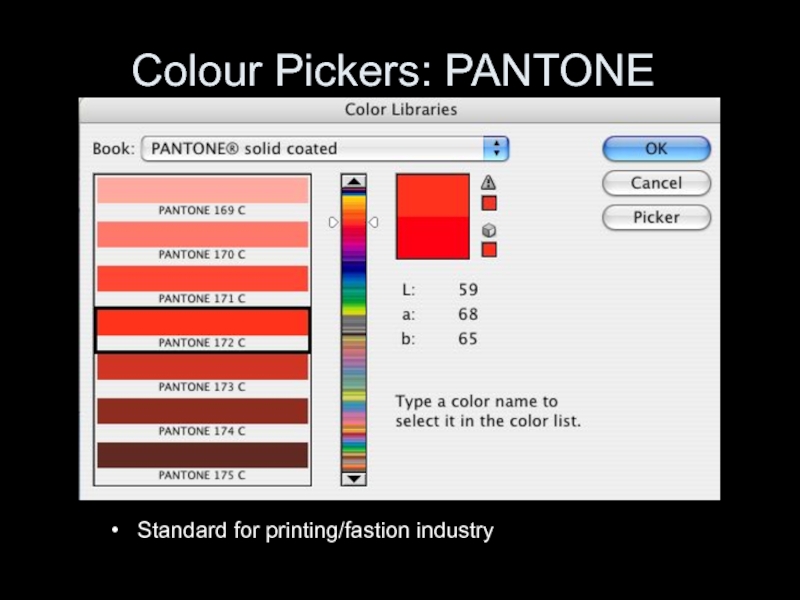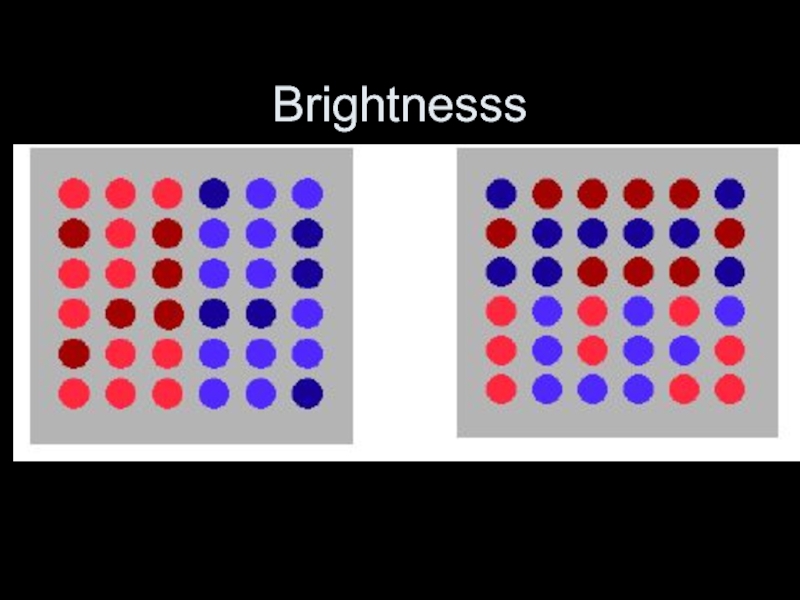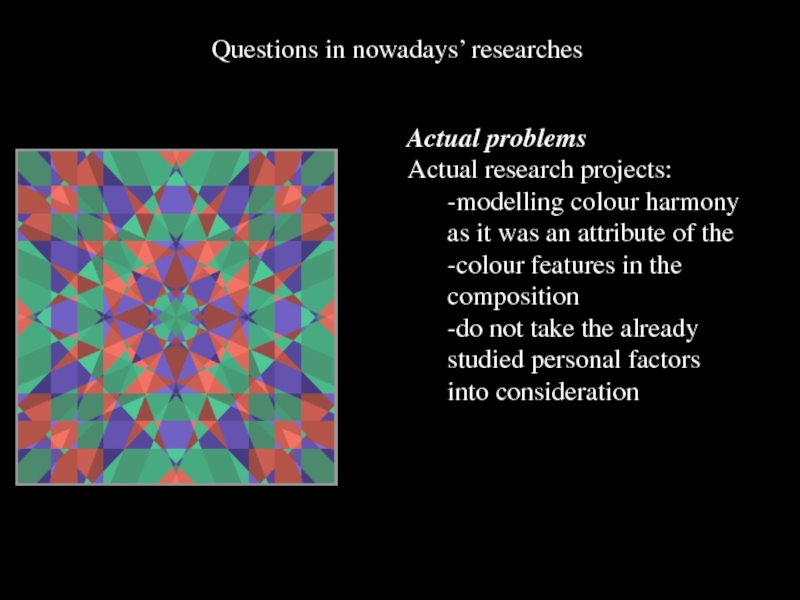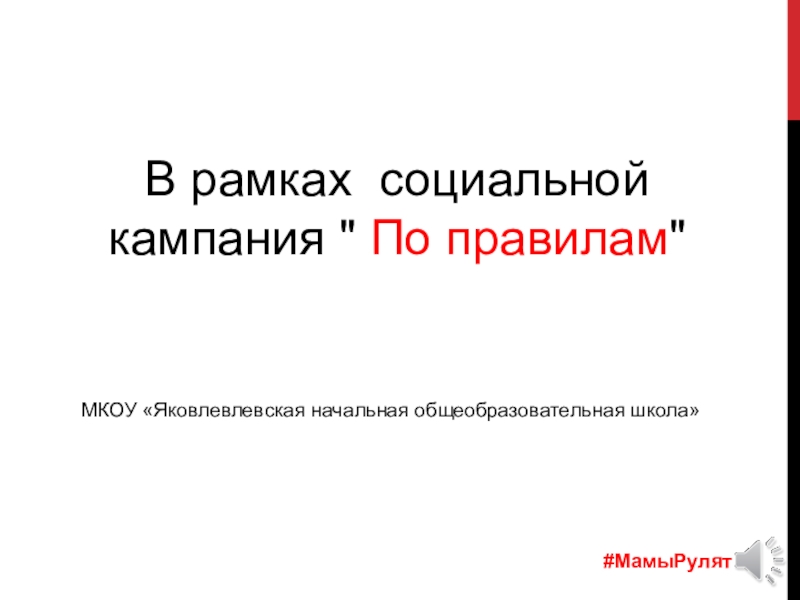Разделы презентаций
- Разное
- Английский язык
- Астрономия
- Алгебра
- Биология
- География
- Геометрия
- Детские презентации
- Информатика
- История
- Литература
- Математика
- Медицина
- Менеджмент
- Музыка
- МХК
- Немецкий язык
- ОБЖ
- Обществознание
- Окружающий мир
- Педагогика
- Русский язык
- Технология
- Физика
- Философия
- Химия
- Шаблоны, картинки для презентаций
- Экология
- Экономика
- Юриспруденция
Colour Theories & Its Applications
Содержание
- 1. Colour Theories & Its Applications
- 2. Scientific & Philosophical Interests & Origins of
- 3. Interpretations of Colour Theory by artistsGoethe’s Theory
- 4. Research on Colour Theory & Nomenclature (names)
- 5. 19th c. theories of “Simultaneous Contrast” and
- 6. Detail
- 7. optical mixing Ex. Pointillism (neo-expressionism)--SeuratComplementary Colours in art & design
- 8. Seurat (details)
- 9. optical effects of adjacent tonal values
- 10. Colour Theory & Practical Applications in DesignPart
- 11. Types of Colour TheoriesSubtractive TheoryThe subtractive, or
- 12. Subtractive TheoryBlack absorbs most lightWhite reflects most
- 13. Additive TheoryBlack radiates no lightWhite (sun) radiates
- 14. The Visible Spectrum
- 15. The Colour WheelIf the ends of the spectrum are bent around a colour wheel is formed:
- 16. The Colour WheelColours on the wheel can
- 17. The Colour Wheel: HueHue or Spectral Colour
- 18. The Colour Wheel: SaturationSaturation or Chroma is
- 19. The Colour Wheel: Value "the quality by which
- 20. The Colour Wheel: Value
- 21. The Colour Wheel: Value
- 22. The Colour Wheel 3dThree parameters to describe a colour: Hue Chroma Value
- 23. Tone = Shade + Tint
- 24. MANY more scientific models based on different
- 25. More Illustrations of the Munsell SystemSource: http://ian-albert.com/graphics/munsell.php
- 26. Scientific & Industry-specific Color systemsCIE (Commission internationale d’éclairage), and MANY others
- 27. Using Color--blue in large regions, not thin
- 28. Colour Schemes Systematic ways of selecting coloursMonochromaticComplimentaryAnalogousWarm CoolAchromaticChromatic Grays
- 29. Colour Schemes: MonochromaticMonochromatic: One Hue many values
- 30. Colour Schemes: Complementary (note spelling--NOT complimentary)Complimentary: Colours
- 31. Color for Categories and Sequences
- 32. Colour Schemes: AnalogousAnalogous: A selection of colours
- 33. Colour Schemes: WarmWarm: First half of the
- 34. Colour Schemes: CoolCool: Second half of the
- 35. Colour Schemes: Achromatic, Chromatic GraysAchromatic: Black and
- 36. Colour Pickers & Choice of MediaHSB, HLS, HSVRGBCMYKOthersLabPANTONEMunsell’s notation wheel
- 37. Colour Pickers: HSB, HLS, HSVHSVHueSaturationValueHSB (Same as HSV)HueSaturationBrightnessHLSHueLightnessSaturation
- 38. Colour Pickers: RGB, CMYKRGB RedGreenBlueUsed in Video
- 39. Photoshop CS3 PickerCombines HSB, RGB,
- 40. Colour Pickers: PANTONEStandard for printing/fastion industry
- 41. Color and the visual display of informationWare, p. 84
- 42. Colour (hue) and counting or searching
- 43. HueNot Usually Pre-attentive
- 44. Hue & shape
- 45. Region SearchHue boundary identifiedpre-attentivelyForm variations do NOTinterfere
- 46. Area EstimationBlue rectangles? Sloped rectangles?
- 47. Fill and Shape
- 48. Brightnesss
- 49. Shape again
- 50. Luminance/Contrast
- 51. Questions in nowadays’ researchesActual problems Actual research
- 52. Скачать презентанцию
Scientific & Philosophical Interests & Origins of Modern Colour TheoryIsaac Newton Opticks 1704 (old spelling of Optics)Used musical scale to divide spectrum and attach names to areasPhysics (but theological implications)
Слайды и текст этой презентации
Слайд 2Scientific & Philosophical Interests & Origins of Modern Colour Theory
Isaac
Newton Opticks 1704 (old spelling of Optics)
Used musical scale to
divide spectrum and attach names to areasPhysics (but theological implications)
Слайд 3Interpretations of Colour Theory by artists
Goethe’s Theory of Colours (1810)
Built
on wavelength theory of light (after Newton)
Methods interesting
Conclusion refuted
Influential on
artistsEx. Turner
Colour theory weblink
Goethe’s Colour Wheel
Слайд 4Research on Colour Theory & Nomenclature (names) by scientists for
aesthetic ‘products’
Michel Eugène Chevreul--Chemist working in Gobelins carpet factory
Noticed optical
mixing of two adjacent colours De la loi du contrast simultané des couleurs 1839
Influential on artists
Слайд 519th c. theories of “Simultaneous Contrast” and optical mixing Ex.
Eugène Delacroix Women of Algiers
Complementary Colours in art & design
Слайд 7optical mixing
Ex. Pointillism (neo-expressionism)--Seurat
Complementary Colours in art & design
Слайд 9 optical effects of adjacent tonal values or colours link to stroboscopic effects
(complementary colours seen as grey)
http://www.michaelbach.de/ot/mot_strob/index.html
Слайд 10Colour Theory & Practical Applications in Design
Part of Pantone color
swatch set with samples of color trends for designers (fall
2008)www.pantone.com
Video Clip from The Devil Wears Prada
Слайд 11Types of Colour Theories
Subtractive Theory
The subtractive, or pigment theory deals
with how white light is absorbed and reflected off of
coloured surfaces.Additive Theory
The Additive, or light theory deals with radiated and filtered light.
Слайд 12Subtractive Theory
Black absorbs most light
White reflects most light
Coloured Pigments absorb
light and reflect only the frequency of the pigment colour.
All colours other than the pigment colours are absorbed so this is called subtractive colour theory.
The primary colours in Subtractive Theory are:
Cyan ( C )
Magenta ( M )
Yellow ( Y )
Black ( K )
Subtractive or Pigment Theory is used in printing and painting.
Слайд 13Additive Theory
Black radiates no light
White (sun) radiates all light
Video is
the process of capturing and radiating light, therefore it uses
Additive (Light) Theory not Subtractive (Pigment) Theory.The primary colours in Additive Theory are:
Red ( R )
Green ( G )
Blue ( B )
The primary colours add together to make white
Light Theory is also called Additive Theory.
Light Theory is used in Television, theater lighting, computer monitors, and video production.
Слайд 16The Colour Wheel
Colours on the wheel can be described using
three parameters:
Hue: degrees from 0˚ to 360˚
Saturation: brightness or dullness
Value:
lightness or darkness(As suggested by Henry Albert Munsell in A Colour Notation, 1905)
Слайд 17The Colour Wheel: Hue
Hue or Spectral Colour is represented as
an angle.
Primary Colours:
0˚ = Red
120˚ = Green
240˚ = Blue
Secondary Colours:
60˚ = Yellow
180˚ = Cyan
300˚ =
Magenta Слайд 18The Colour Wheel: Saturation
Saturation or Chroma is the intensity of
a colour.
A highly saturated colour is bright and appears closer
to the edge of the wheel.A more unsaturated colour is dull.
A colour with no saturation is achromatic or in the grey scale.
Слайд 19The Colour Wheel: Value
"the quality by which we distinguish a
light colour from a dark one."
Albert Henry Munsell
A Colour
Notation 1905Value represents the luminescent contrast value between black and white
Слайд 24MANY more scientific models based on different colour theory: (Example:
Colour Tree by American artist Henry Albert Munsell from A Colour
Notation, 1905.)Слайд 26Scientific & Industry-specific Color systems
CIE (Commission internationale d’éclairage),
and MANY
others
Слайд 27Using Color--
blue in large regions, not thin lines
red and green
in the center of the field of view (edges of retina
not sensitive to these)black, white, yellow in periphery
Color Brewer
Pantone
Слайд 28Colour Schemes
Systematic ways of selecting colours
Monochromatic
Complimentary
Analogous
Warm
Cool
Achromatic
Chromatic Grays
Слайд 29Colour Schemes: Monochromatic
Monochromatic:
One Hue many values of Tint and
Shade
Artist: Marc Chagall
Title: Les Amants Sur Le Toit
Слайд 30Colour Schemes: Complementary (note spelling--NOT complimentary)
Complimentary: Colours that are opposite
on the wheel. High Contrast
Artist: Paul Cezanne
Title: La Montage
Saint VictoireYear: 1886-88
Слайд 32Colour Schemes: Analogous
Analogous: A selection of colours that are adjacent.
Minimal contrast
Artist: Vincent van Gogh
Title: The Iris
Year: 1889
Слайд 33Colour Schemes: Warm
Warm: First half of the wheel give warmer
colours. The colours of fire.
Artist: Jan Vermeer
Title: Girl Asleep at
a Table Year: 1657
Слайд 34Colour Schemes: Cool
Cool: Second half of the wheel gives cooler
colours
Artist: Pablo Picasso
Title: Femme Allongée Lisant
Year: 1939
Слайд 35Colour Schemes:
Achromatic, Chromatic Grays
Achromatic: Black and white with all the
grays in-between.
Chromatic Grays: Also called neutral relief. Dull colours, low
contrast.Слайд 36Colour Pickers & Choice of Media
HSB, HLS, HSV
RGB
CMYK
Others
Lab
PANTONE
Munsell’s notation wheel
Слайд 37Colour Pickers: HSB, HLS, HSV
HSV
Hue
Saturation
Value
HSB (Same as HSV)
Hue
Saturation
Brightness
HLS
Hue
Lightness
Saturation
Слайд 38Colour Pickers: RGB, CMYK
RGB
Red
Green
Blue
Used in Video and Computer graphics
3
Values in % or between
0-255
CMYK
Cyan
Magenta
Yellow
K = Black
Used for printing
Слайд 39Photoshop CS3 Picker
Combines
HSB,
RGB,
CMYK,
Lab
(Luminance, Red/Green, Yellow/Blue)
Adobe
http://kuler.adobe.com/
Слайд 45Region Search
Hue boundary identified
pre-attentively
Form variations do NOT
interfere with hue
boundary identification
Form
boundary NOT
identified pre-attentively
Hue variations interfere
with form boundary
identification
Слайд 51Questions in nowadays’ researches
Actual problems
Actual research projects:
-modelling colour harmony
as it was an attribute of the -colour features in
the composition-do not take the already studied personal factors into consideration









